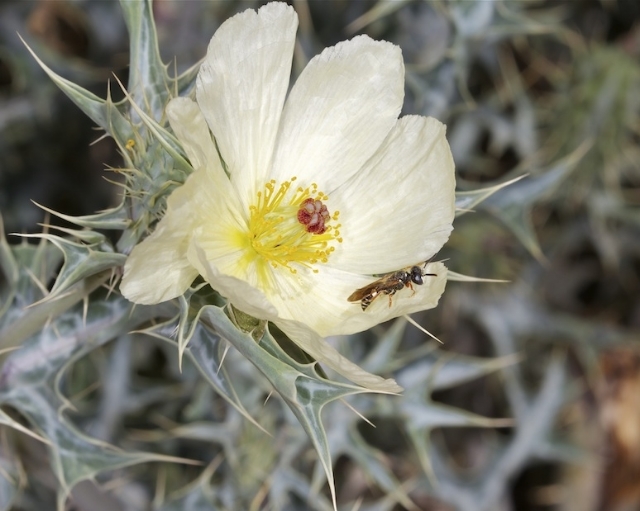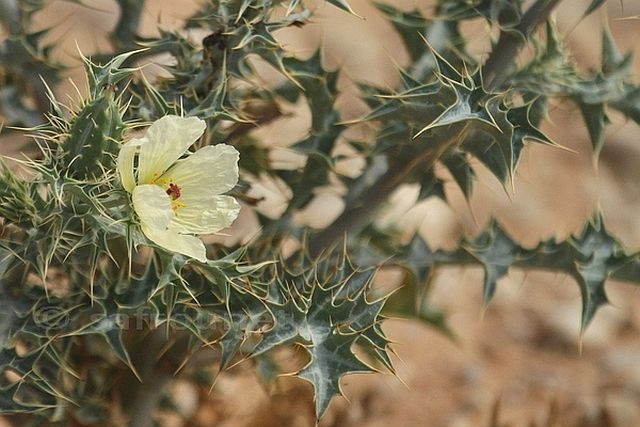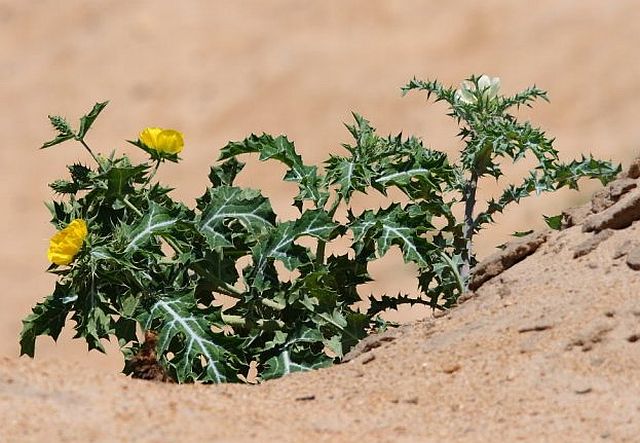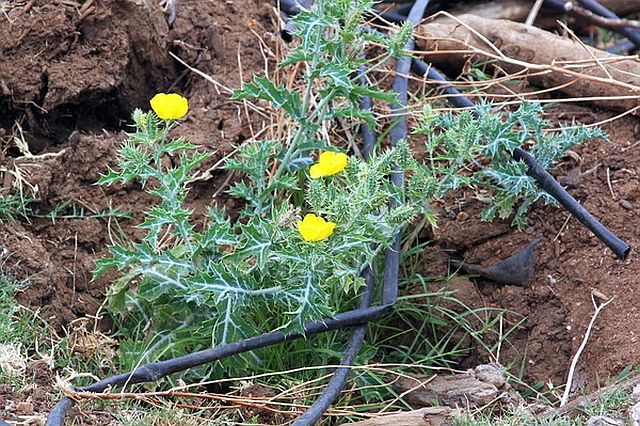Index to Flowers in the Order Ranunculales
Family: Papaveraceae
Argemone mexicana Yellow-flowered Mexican Poppy https://africawild-forum.com/viewtopic.p ... 61#p178861
Argemone ochroleuca ochroleuca White-flowered Mexican Poppy https://africawild-forum.com/viewtopic.p ... 32#p178532
Africa Wild Flower Book - Order Ranunculales
Moderator: Klipspringer
Re: Africa Wild Flower Book - Order Ranunculales
Prickly Poppy, Mexican Poppy, Devil's Fig Argemone ochroleuca, Argemone subfusiformis Witblombloudissels
Family Papaveraceae
Note: Two color forms occur, bright yellow and cream colored. Both appear to be equally common. Some authors have treated this as a separate species, namely Argemone ochroleuca Sweet subsp. ochroleuca, but will be treated as synonyms here.
 © ExFmem
© ExFmem
White-flowered Mexican poppy: Argemone ochroleuca subsp. ochroleuca
 © ExFmem
© ExFmem
Oct. Kamqua Picnic Site, Kgalagadi Transfrontier National Park
Worldwide Distribution
Native of Central and tropical South America, a declared invader plant in South Africa.
Habitat
A weed of waste land, disturbed sites and sandy river beds.
Description
The prickly stems are conspicuously bluish-green or greyish-green in color (i.e. glaucous) and much-branched in nature. Stems and leaves are also hairless (i.e. glabrous) and exude a yellowish sap when broken or damaged.
The leaves are initially arranged in a basal rosette and then are alternately arranged along the upright erect stems that develop as the plant matures. These leaves (7-15 cm long and 2-6 cm wide) are also bluish-green or greyish-green in color, with whitish-colored veins that give them a variegated appearance. They are deeply divided (pinnatifid) or sharply toothed (serrate) and have several sharp spines on their margins. As the plant ages the leaves of the basal rosette die off.
The spiny flower buds are oblong in shape (8-18 mm long and 4-11 mm wide) and consist of three sepals, each of which is topped with a horn-like projection (5-12 mm long). When the flowers open they are quite showy (3-7 cm across) with six pale yellow, lemon or cream-colored petals (about 25 mm long). They also have numerous (20-75) stamens and a purplish stigma with spreading lobes exposing bluish-green colored surfaces between them. Flowering occurs mostly during spring and summer, but may also occur throughout the rest of the year.
The spiny capsules and are generally oval, oblong or egg-shaped and usually have five compartments (occasionally 3-6). These capsules (20-50 mm long and 10-18 mm wide) turn brown in color as they mature and split open, from the top downwards, to release the numerous seeds contained within. The seeds (1.5-2 mm long) are rounded in shape, black or brown in color, and have a pitted surface.
This species reproduces via large numbers of seed. These seeds may be spread by water, in mud or in contaminated agricultural produce (e.g. grain, pasture seeds and fodder). The entire plant is also known to break off at the base when it dies off and can be blown long distances, thereby helping to spread any seed still present in the old capsules.
Environmental and other impacts
This species is an agricultural weed. All parts of the plant are toxic to animals and man, but accounts of livestock poisoning are rare because it is generally avoided by animals. The main danger to livestock, horses and poultry usually comes from fodder and other stock feeds that have become contaminated with its leaves or seeds. Its very prickly nature also means it can cause injury to humans and livestock.
A. ochroleuca has been listed as a noxious weed in South Africa (prohibited plants that must be controlled. They serve no economic purpose and possess characteristics that are harmful to humans, animals or the environment).
 © nan
© nan
Kgalagadi Transfrontier Park
Family Papaveraceae
Note: Two color forms occur, bright yellow and cream colored. Both appear to be equally common. Some authors have treated this as a separate species, namely Argemone ochroleuca Sweet subsp. ochroleuca, but will be treated as synonyms here.
 © ExFmem
© ExFmemWhite-flowered Mexican poppy: Argemone ochroleuca subsp. ochroleuca
 © ExFmem
© ExFmemOct. Kamqua Picnic Site, Kgalagadi Transfrontier National Park
Worldwide Distribution
Native of Central and tropical South America, a declared invader plant in South Africa.
Habitat
A weed of waste land, disturbed sites and sandy river beds.
Description
The prickly stems are conspicuously bluish-green or greyish-green in color (i.e. glaucous) and much-branched in nature. Stems and leaves are also hairless (i.e. glabrous) and exude a yellowish sap when broken or damaged.
The leaves are initially arranged in a basal rosette and then are alternately arranged along the upright erect stems that develop as the plant matures. These leaves (7-15 cm long and 2-6 cm wide) are also bluish-green or greyish-green in color, with whitish-colored veins that give them a variegated appearance. They are deeply divided (pinnatifid) or sharply toothed (serrate) and have several sharp spines on their margins. As the plant ages the leaves of the basal rosette die off.
The spiny flower buds are oblong in shape (8-18 mm long and 4-11 mm wide) and consist of three sepals, each of which is topped with a horn-like projection (5-12 mm long). When the flowers open they are quite showy (3-7 cm across) with six pale yellow, lemon or cream-colored petals (about 25 mm long). They also have numerous (20-75) stamens and a purplish stigma with spreading lobes exposing bluish-green colored surfaces between them. Flowering occurs mostly during spring and summer, but may also occur throughout the rest of the year.
The spiny capsules and are generally oval, oblong or egg-shaped and usually have five compartments (occasionally 3-6). These capsules (20-50 mm long and 10-18 mm wide) turn brown in color as they mature and split open, from the top downwards, to release the numerous seeds contained within. The seeds (1.5-2 mm long) are rounded in shape, black or brown in color, and have a pitted surface.
This species reproduces via large numbers of seed. These seeds may be spread by water, in mud or in contaminated agricultural produce (e.g. grain, pasture seeds and fodder). The entire plant is also known to break off at the base when it dies off and can be blown long distances, thereby helping to spread any seed still present in the old capsules.
Environmental and other impacts
This species is an agricultural weed. All parts of the plant are toxic to animals and man, but accounts of livestock poisoning are rare because it is generally avoided by animals. The main danger to livestock, horses and poultry usually comes from fodder and other stock feeds that have become contaminated with its leaves or seeds. Its very prickly nature also means it can cause injury to humans and livestock.
A. ochroleuca has been listed as a noxious weed in South Africa (prohibited plants that must be controlled. They serve no economic purpose and possess characteristics that are harmful to humans, animals or the environment).
 © nan
© nanKgalagadi Transfrontier Park
Re: Africa Wild Flower Book - Order Ranunculales
Yellow-flowered Mexican Poppy, Devil’s Fig, Texas Poppy Argemone mexicana (Geelblom, Geelblombloudissel)
Order: Ranunculales. Family: Papaveraceae
 © Flutterby
© Flutterby
Kruger National Park
Description
Very spiny annual herb growing up to 90 cm high with stems that exude a yellow sap when cut. Grey or bluish-green spiny leaves with prominent white veins. Bright yellow flowers appear from September to January. Spiny, egg-shaped green fruit capsules turn brown and release numerous small black seeds. Poisonous, sap and spines cause skin irritation.
Distribution
A declared Category 1 invader plant in South Africa. Invader plants must be removed & destroyed immediately . The exact native range of this species is obscure, but it is often thought to be native to south-eastern USA (Florida), Mexico, Central America, the Caribbean and tropical South America. Argemone mexicana is naturalised throughout the tropics and sub-tropics as an agricultural weed. In South Africa, it occurs in KwaZulu-Natal and the lowveld of Mpumalanga and Limpopo Provinces.
. The exact native range of this species is obscure, but it is often thought to be native to south-eastern USA (Florida), Mexico, Central America, the Caribbean and tropical South America. Argemone mexicana is naturalised throughout the tropics and sub-tropics as an agricultural weed. In South Africa, it occurs in KwaZulu-Natal and the lowveld of Mpumalanga and Limpopo Provinces.
Habitat
It is prolific in disturbed sites.
 © nan
© nan
Kruger National Park, H14
Order: Ranunculales. Family: Papaveraceae
 © Flutterby
© FlutterbyKruger National Park
Description
Very spiny annual herb growing up to 90 cm high with stems that exude a yellow sap when cut. Grey or bluish-green spiny leaves with prominent white veins. Bright yellow flowers appear from September to January. Spiny, egg-shaped green fruit capsules turn brown and release numerous small black seeds. Poisonous, sap and spines cause skin irritation.
Distribution
A declared Category 1 invader plant in South Africa. Invader plants must be removed & destroyed immediately
Habitat
It is prolific in disturbed sites.
 © nan
© nanKruger National Park, H14


